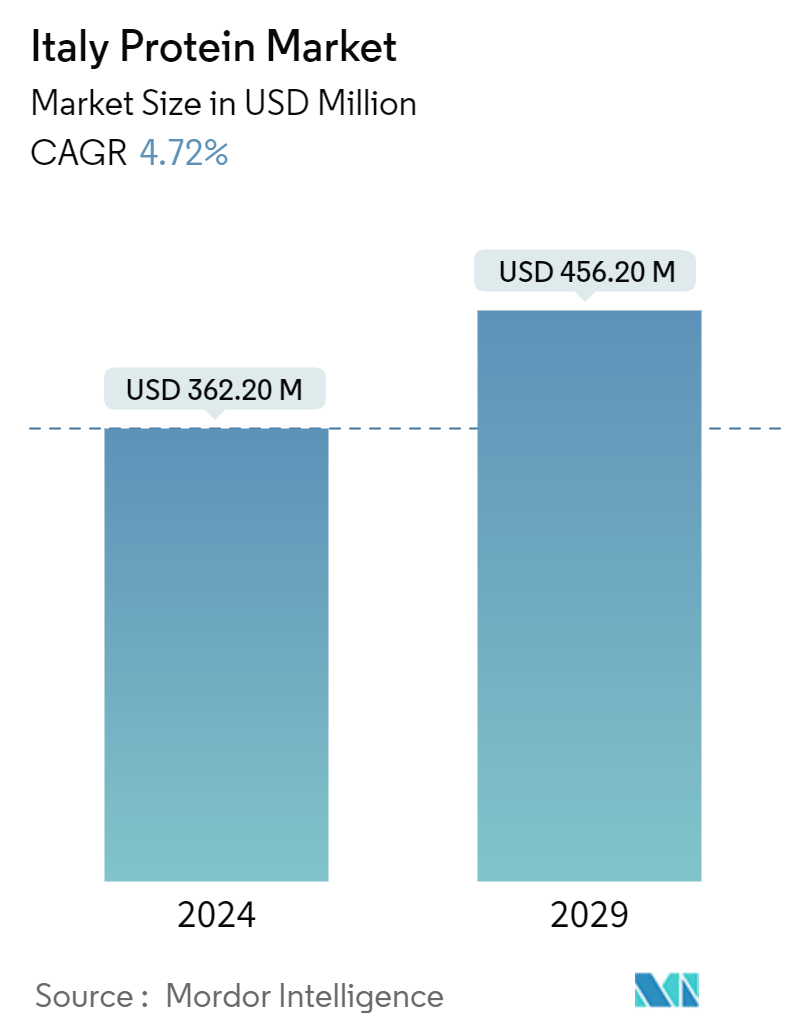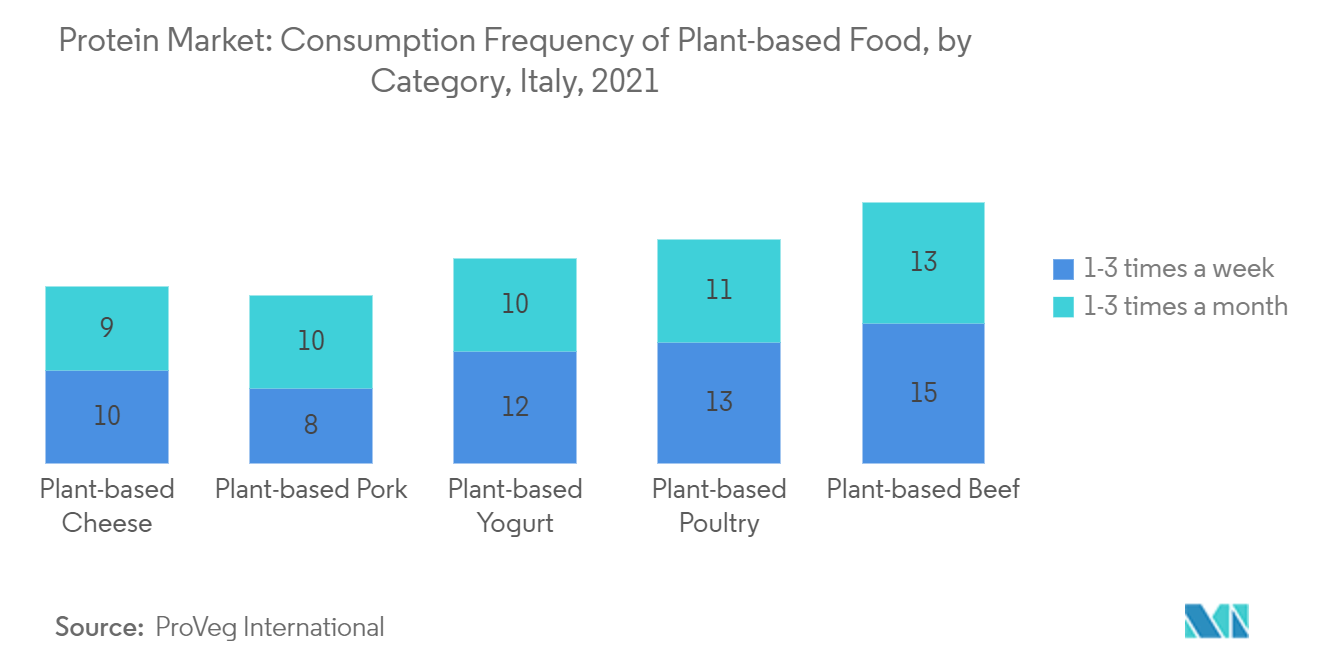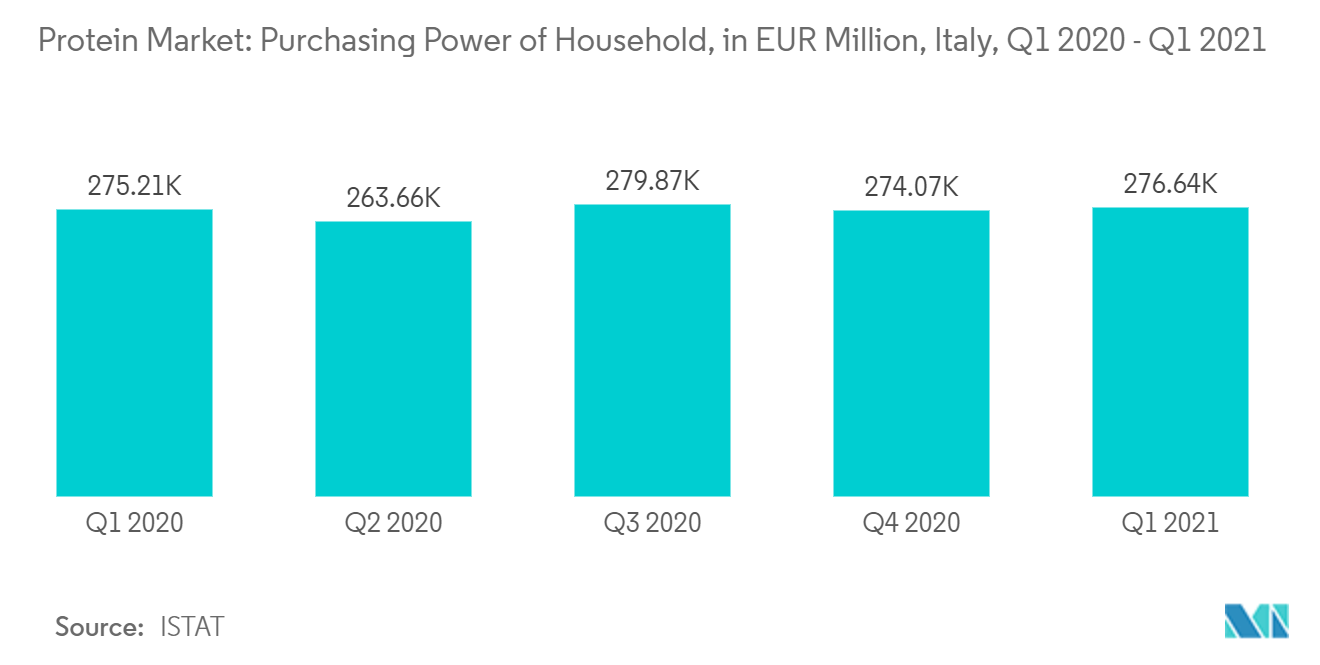Italy Protein Market Size

| Study Period | 2019 - 2029 |
| Base Year For Estimation | 2023 |
| Market Size (2024) | USD 362.20 Million |
| Market Size (2029) | USD 456.20 Million |
| CAGR (2024 - 2029) | 4.72 % |
| Market Concentration | Low |
Major Players.webp)
*Disclaimer: Major Players sorted in no particular order |
Italy Protein Market Analysis
The Italy Protein Market size is estimated at USD 362.20 million in 2024, and is expected to reach USD 456.20 million by 2029, growing at a CAGR of 4.72% during the forecast period (2024-2029).
- Plant-based alternatives are a recent trend in the market, with consumers leaning towards alternatives as they opt for a more sustainable diet and lifestyle. Italian consumers are, in turn, reacting to this change while looking for dairy alternatives. Dairy products are a key aspect of the daily diet of Italian consumers, with the majority of the population consuming milk, butter, cheese, and cream daily.
- Consumers in Italy are actively looking out for nutritional labeling and hence opting for dairy alternatives as a source of protein. Hence, there exists an opportunity for manufacturers to offer pea, wheat, rice, and soy protein-based products in line with consumer demand, which in turn is likely to support the growth of plant protein in Italy.
- Government measures to promote plant protein consumption benefited the market. The Italian Ministry of the Environment opposed the excessive consumption of animal proteins, proposing to replace them with plant proteins. As oat protein is a rich source of beta-glucan fiber, which helps in the proper function of the bowel system, it is largely propelling the consumption of oat protein in the country. Consequently, health professionals and consumers alike are now seeking healthier dietary options to combat obesity and its associated health risks.
- For instance, as per the European Academy of Allergy and Clinical Immunology (EAACI), nearly 4% of children in Italy suffer from food allergies. Also, According to the Ministry of Health, Italy, in 2021, the prevalence of celiac disease among the Italian population was equal to 0.41 %.
Italy Protein Market Trends
Growing Consumer Preference for Protein-Fortified Foods
- The high protein claim trend is gaining traction in European countries like Italy, where the number of high protein claims on the launches of food and drinks is steadily increasing. In Italy, the percentage of products with high protein claims is low. Still, the absolute number has increased significantly in recent years, making 'high in protein' one of the most popular claims in the Italian food and drinks market.
- Italian consumers are looking for more milk protein not only in their food but also in their drinks and snacks. As the geriatric population increases in Italy, medical nutritional products that support bone and muscle maintenance are in high demand. Hence, animal protein ingredients like milk protein ingredients have been in high demand in recent years. High protein/protein-infused foods and beverages are becoming more popular on retail shelves in Italy.
- According to the Union Food Association of Italy, in 2021, about 37.9% of Italian households made vegetable meat part of their food choices, reaching an estimated 22 million consumers. The changing consumer perceptions in the country towards plant-based protein-fortified and healthy foods are mainly driving the segment. The high demand from these industries largely boosted the country's consumption of soy and wheat proteins. Furthermore, mainstream consumers understand that protein supports satiety, weight loss and management, and muscle building and maintenance.
- Owing to high nutritional quality and versatile functional properties, plant protein ingredients are widely used in many food formulations, such as dairy desserts, nutritional beverages, ice cream, yogurt, spreads, meat products, confectionery, and baked goods.

Food and Beverage is the Largest End User
- Italy, renowned for its culinary heritage and gastronomic prowess, has witnessed a profound shift in dietary patterns. As the food and beverage sector embraces innovation and adapts to changing consumer demands, protein-rich products have emerged as a central focus. The contemporary consumer, cognizant of health and wellness trends, increasingly seeks protein sources not only for muscle-building purposes but also for their role in weight management, satiety, and overall well-being.
- The rise of health consciousness has spurred a demand for protein-infused edibles, prompting food and beverage manufacturers to revamp their product portfolios. From protein-fortified pasta and bread to beverages enriched with plant-based proteins, the market landscape has undergone a notable transformation. This paradigm shift has catalyzed a symbiotic relationship between the food and beverage sector and the protein market, as both industries mutually reinforce and stimulate each other's growth.
- Furthermore, technological advancements have expedited the production and distribution of protein-rich offerings. Novel processing techniques and ingredient innovations have enabled manufacturers to develop products that not only meet nutritional requirements but also appeal to evolving palates. The diversification of protein sources, including plant-based alternatives like soy, pea, and lentil proteins, resonates with the burgeoning trend of flexitarianism and veganism, thus expanding the consumer base and propelling market expansion. In addition, the rising per capita income and purchasing power of households is one of the driving factors for Italy's protein market. According to the Economy and Finance (Italy), the average income of Italians in 2021 stood at EUR 22,540.

Italy Protein Industry Overview
The Italy protein market is fragmented, with the presence of various international and domestic players. The major players in this market are Archer Daniels Midland Company, Darling Ingredients Inc., Kerry Group PLC, International Flavors & Fragrances Inc., and Koninklijke FrieslandCampina N.V., among others. Key protein market players are investing in R&D and entering into mergers and acquisitions to enhance their product portfolios. Owing to the rapidly developing nature of the market, new product innovation has become the most commonly used strategy among all, as it helps in understanding the changing needs of the consumers in the market. The demand for plant-based ingredients is growing in the region due to consumers' increasing demand for vegan and plant-based foods.
Italy Protein Market Leaders
-
Archer Daniels Midland Company
-
Darling Ingredients Inc.
-
Kerry Group PLC
-
International Flavors & Fragrances Inc.
-
Koninklijke FrieslandCampina N.V.
*Disclaimer: Major Players sorted in no particular order
.webp)
Italy Protein Market News
- October 2022: Roquette Freres introduced four new grades of organic pea protein isolates and starches to the European, Italian, and United States markets. These organic peas were sourced from Canada.
- August 2021: Arla Foods Ingredients unveiled MicelPure™, a micellar casein isolate product. This new micellar casein isolate boasts a minimum protein content of 87%, low levels of lactose and fat, heat stability, and a neutral taste profile. It finds prominent use in ready-to-drink (RTD) beverages, high-protein beverages, and powdered shakes.
- February 2021: Lactalis Ingredients launched Pronativ Native Micellar Casein, marketed as a pure and natural protein. This product utilizes a cold filtration process to extract whey directly from milk without the addition of any additives or chemicals.
Italy Protein Market Report - Table of Contents
1. INTRODUCTION
- 1.1 Study Assumptions & Market Definition
- 1.2 Scope of the Study
2. RESEARCH METHODOLOGY
3. EXECUTIVE SUMMARY
4. MARKET DYNAMICS
-
4.1 Drivers
- 4.1.1 Increased Demand For Plant Based Proteins
- 4.1.2 Growing Consumer Preference for Protein-Fortified Foods
-
4.2 Restarints
- 4.2.1 Allergies Associated with Animal Proteins Hamper the Market Growth
-
4.3 Porter's Five Forces Analysis
- 4.3.1 Threat of New Entrants
- 4.3.2 Bargaining Power of Buyers/Consumers
- 4.3.3 Bargaining Power of Suppliers
- 4.3.4 Threat of Substitute Products
- 4.3.5 Intensity of Competitive Rivalry
5. MARKET SEGMENTATION
-
5.1 Source
- 5.1.1 Animal
- 5.1.1.1 Casein and Caseinates
- 5.1.1.2 Collagen
- 5.1.1.3 Egg Protein
- 5.1.1.4 Gelatin
- 5.1.1.5 Insect Protein
- 5.1.1.6 Milk Protein
- 5.1.1.7 Whey Protein
- 5.1.1.8 Other Animal Protein
- 5.1.2 Microbial
- 5.1.2.1 Algae Protein
- 5.1.2.2 Mycoprotein
- 5.1.3 Plant
- 5.1.3.1 Hemp Protein
- 5.1.3.2 Oat Protein
- 5.1.3.3 Pea Protein
- 5.1.3.4 Potato Protein
- 5.1.3.5 Rice Protein
- 5.1.3.6 Soy Protein
- 5.1.3.7 Wheat Protein
- 5.1.3.8 Other Plant Protein
-
5.2 End-User
- 5.2.1 Animal Feed
- 5.2.2 Personal Care and Cosmetics
- 5.2.3 Food and Beverages
- 5.2.3.1 Bakery
- 5.2.3.2 Beverages
- 5.2.3.3 Breakfast Cereals
- 5.2.3.4 Condiments/Sauces
- 5.2.3.5 Confectionery
- 5.2.3.6 Dairy and Dairy Alternative Products
- 5.2.3.7 Meat/Poultry/Seafood and Meat Alternative Products
- 5.2.3.8 RTE/RTC Food Products
- 5.2.3.9 Snacks
- 5.2.4 Supplements
- 5.2.4.1 Baby Food and Infant Formula
- 5.2.4.2 Elderly Nutrition and Medical Nutrition
- 5.2.4.3 Sport/Performance Nutrition
6. COMPETITIVE LANDSCAPE
- 6.1 Market Positioning Analysis
- 6.2 Market Share Analysis
-
6.3 Company Profiles
- 6.3.1 Archer Daniels Midland Company
- 6.3.2 Arla Foods amba
- 6.3.3 Koninklijke FrieslandCampina N.V.
- 6.3.4 Darling Ingredients Inc.
- 6.3.5 International Flavors & Fragrances Inc.
- 6.3.6 Groupe Lactalis
- 6.3.7 Südzucker AG
- 6.3.8 Kerry Group PLC
- 6.3.9 Lactoprot Deutschland GmbH
- 6.3.10 Laita
- 6.3.11 Roquette Frères
- *List Not Exhaustive
7. MARKET OPPORTUNITIES AND FUTURE TRENDS
** Subject To AvailablityItaly Protein Industry Segmentation
The protein market refers to the global industry involved in the production, distribution, and consumption of protein-based products. This can encompass a wide range of proteins, including those from animal sources (such as meat, poultry, and dairy) and plant-based sources (such as soy, pea, and wheat protein). The protein market is significant and diverse, as proteins are essential nutrients for human health and are used extensively in various food and beverage products, dietary supplements, animal feed, and more. In recent years, there has been a growing interest in alternative and plant-based proteins to address sustainability and health concerns, which has led to innovations and changes within the protein market.
The Italy protein market is segmented by source and by end user. By source, the market is segmented into animal, microbial, and plant protein. The animal protein segment is further sub-segmented into casein and caseinates, collagen, egg protein, gelatin, insect protein, whey protein, milk protein, and other animal protein. The microbial protein is sub-segmented into algae protein and mycoprotein. The plant protein is sub-segmented into hemp protein, oat protein, pea protein, potato protein, rice protein, soy protein, wheat protein, and other plant proteins. Based on end-users, the market is segmented into animal feed, personal care and cosmetics, food and beverages, and supplements. The food and beverage segment is sub-segmented into the bakery, beverages, breakfast cereals, condiments/sauces, confectionery, dairy, and dairy alternative products, meat/poultry/seafood & meat alternative products, RTC/RTE food products, and snacks. The supplements are further sub-segmented into baby food and infant formula, elderly nutrition and medical nutrition, and sports/performance nutrition.
The market sizing has been done in value terms in USD and for volume terms in volume in tons for all the abovementioned segments.
| Source | Animal | Casein and Caseinates |
| Collagen | ||
| Egg Protein | ||
| Gelatin | ||
| Insect Protein | ||
| Milk Protein | ||
| Whey Protein | ||
| Other Animal Protein | ||
| Source | Microbial | Algae Protein |
| Mycoprotein | ||
| Source | Plant | Hemp Protein |
| Oat Protein | ||
| Pea Protein | ||
| Potato Protein | ||
| Rice Protein | ||
| Soy Protein | ||
| Wheat Protein | ||
| Other Plant Protein | ||
| End-User | Animal Feed | |
| Personal Care and Cosmetics | ||
| Food and Beverages | Bakery | |
| Beverages | ||
| Breakfast Cereals | ||
| Condiments/Sauces | ||
| Confectionery | ||
| Dairy and Dairy Alternative Products | ||
| Meat/Poultry/Seafood and Meat Alternative Products | ||
| RTE/RTC Food Products | ||
| Snacks | ||
| Supplements | Baby Food and Infant Formula | |
| Elderly Nutrition and Medical Nutrition | ||
| Sport/Performance Nutrition |
Italy Protein Market Research FAQs
How big is the Italy Protein Market?
The Italy Protein Market size is expected to reach USD 362.20 million in 2024 and grow at a CAGR of 4.72% to reach USD 456.20 million by 2029.
What is the current Italy Protein Market size?
In 2024, the Italy Protein Market size is expected to reach USD 362.20 million.
Who are the key players in Italy Protein Market?
Archer Daniels Midland Company, Darling Ingredients Inc., Kerry Group PLC, International Flavors & Fragrances Inc. and Koninklijke FrieslandCampina N.V. are the major companies operating in the Italy Protein Market.
What years does this Italy Protein Market cover, and what was the market size in 2023?
In 2023, the Italy Protein Market size was estimated at USD 345.10 million. The report covers the Italy Protein Market historical market size for years: 2019, 2020, 2021, 2022 and 2023. The report also forecasts the Italy Protein Market size for years: 2024, 2025, 2026, 2027, 2028 and 2029.
Italy Protein Industry Report
Statistics for the 2024 Italy Protein market share, size and revenue growth rate, created by Mordor Intelligence™ Industry Reports. Italy Protein analysis includes a market forecast outlook to for 2024 to 2029 and historical overview. Get a sample of this industry analysis as a free report PDF download.



